A New Double-Step Process of Shortening Fibers without Change in Molding Equipment Followed by Electron Beam to Strengthen Short Glass Fiber Reinforced Polyester BMC
Abstract
1. Introduction
2. Materials and Methods
2.1. Preparation of SGFRP-BMC Samples
2.2. Homogeneous Low-Voltage Electron Beam Irradiation
2.3. Charpy Impact Tests
3. Results
Effect of Shortening SGFs and HLEBI on Impact Values
4. Discussion
4.1. Average Impact Strength
4.2. Micro-Strengthening Mechanism Using Extended Mix
4.3. Nano-Strengthening Mechanism Using HLEBI
4.4. Environmental Sustainability and Long-Term Durability Aspects
4.5. Economic Analysis, Scale-Up, and Feasibility Studies
5. Conclusions
- Therefore, a new double-step process of: (1) shortening the nominal 6.4 mm fiber length formulation to submilllimeter 0.44 mm by 30 min extended mixing without change in molding equipment, followed by (2) applying 0.86 MGy dose of homogeneous low-voltage electron beam irradiation (HLEBI) to both sides of the finished samples, requiring no chemicals or additives, which is shown to increase Charpy impact value (auc) over 50% from 6.26 to 9.59 kJm−2 at a median-accumulative probability of fracture, Pf = 0.500.
- Shortening the SGFs by the extended mix method to submillimeter creates a higher number of thermal micro-compressive stress sites between SGF and the matrix to increase impact strength. This is performed by a mismatch of the coefficient of thermal expansion (CTE) between the matrix and fibers acting in the increased fiber spacing density while the composite is undergoing cool-down and shrinkage. In concert with this, since the SGFRP-BMC is a 3-phase fiber-filler-polymer system, the filled matrix behaves as a polymer-filler subsystem in the narrow spacing between fibers that efficiently allows for the increase in mechanical properties by decreasing the fiber length.
- To boost impact strength further, HLEBI additionally provides nano-compressive stresses in the matrix by generating a dangling bond, which acts as repulsive force site between the outer-shell lone-pair electrons. This, along with increasing SGF/matrix adhesion, occurs with the optimum dose of HLEBI. During impact, a higher degree of internal cracking apparently occurs, raising the impact strength of SFGFRP-BMC samples.
Author Contributions
Funding
Institutional Review Board Statement
Informed Consent Statement
Data Availability Statement
Acknowledgments
Conflicts of Interest
Abbreviations
| SGFRP-BMC | short glass fiber reinforced polymer bulk molding compound |
| SGF | short glass fiber |
| CTE | coefficient of thermal expansion |
| HLEBI | homogeneous low-voltage electron beam irradiation |
| DB | dangling bond |
| FRP | fiber-reinforced polymer |
| Symbols | |
| auc | Charpy impact strength (kJm−2) |
| Sf | fiber spacing density (mm−3) |
| Nf | fiber number density (mm−3) |
| Vf | volume fraction |
| r | fiber radius (mm) |
| lf | fiber length (mm) |
| BDE | bond dissociation energy (kJ mol−1) |
| D | HLEBI irradiation dose (MGy) |
| I | HLEBI irradiation current (mA) |
| S | HLEBI conveyor speed (mmin−1) |
| N | HLEBI number of irradiations |
| Dth | HLEBI penetration depth (µm) |
| V | HLEBI acceleration voltage (V) |
| ρ | sample density (g mm−3) |
| E | impact fracture energy (kJ) |
| W | impact hammer mass (kg) |
| R | length of hammer weight point from pivot center (m) |
| β | maximum angle after impact (Rad) |
| α | start angle before impact (Rad) |
| α’ | maximum angle of a blank test (Rad) |
| b | specimen width (mm) |
| t | specimen thickness (mm) |
| Pf | accumulative probability |
| IR | ascending strength rank |
| Ns | total number of samples in a data set |
References
- Faudree, M.; Nishi, Y.; Gruskiewicz, M.; Salvia, M. A new glass fibered reinforced composite with improved Charpy impact properties at low and high temperatures beyond the extremes of aircraft flight. Mater. Trans. 2018, 59, 1280–1287. [Google Scholar] [CrossRef]
- Matykiewicz, D.; Barczewski, M.; Sterzyński, T. Morphology and thermomechanical properties of epoxy composites highly filled with waste bulk molding compounds (BMC). J. Polym. Eng. 2015, 35, 805–811. [Google Scholar] [CrossRef]
- DeRosa, R.; Telfeyan, E.; Gaustad, G.; Mayes, S. Strength and microscopic investigation of unsaturated polyester BMC reinforced with SMC-Recyclate. J. Thermoplast. Compos. Mater. 2005, 18, 333–349. [Google Scholar] [CrossRef]
- Rajaee, P.; Ghasemi, F.A.; Fasihi, M.; Saberian, M. Experimental Analysis and Optimization of Mechanical and Physical Properties of Light-Weight Bulk Molding Compound by Design of Experiment. J. Macromol. Sci. Part B 2021, 60, 237–256. [Google Scholar] [CrossRef]
- Lee, T.; Jeong, K.; Kim, D. Development of a lightweight BMC material using fly ash. Adv. Compos. Mater. 2017, 26, 55–64. [Google Scholar] [CrossRef]
- Faudree, M.; Nishi, Y.; Gruskiewicz, M. Characterization of velocity profile of highly-filled GFRP-BMC through rectangular-duct shaped specimen during injection molding from SEM fiber orientation mapping. Mater. Trans. 2013, 54, 1877–1883. [Google Scholar] [CrossRef]
- Faudree, M.C.; Nishi, Y. Tensile Strength Enhancement by Shortening Glass Fibers with Sub-Millimeter Length in Bulk Molding Polymer Compound. Mater. Trans. 2010, 51, 2304–2310. [Google Scholar] [CrossRef]
- Faudree, M.C.; Nishi, Y.; Gruskiewicz, M. A Novel ‘Fiber Spacing’ Model of Tensile Modulus Enhancement by Shortening Fibers to Sub-Millimeter in an Injection-Molded Glass Fiber Reinforced Polymer Bulk Molding Compound (GFRP-BMC). Mater. Trans. 2014, 55, 1292–1298. [Google Scholar] [CrossRef]
- Singh, H.; Singh, T. Effect of fillers of various sizes on mechanical characterization of natural fiber polymer hybrid composites: A review. Mater. Today Proc. 2019, 18, 5345–5350. [Google Scholar] [CrossRef]
- Rajaee, P.; Ghasemi, F.A.; Fasihi, M.; Saberian, M. Effect of styrene-butadiene rubber and fumed silica nano-filler on the microstructure and mechanical properties of glass fiber reinforced unsaturated polyester resin. Compos. Part B Eng. 2019, 173, 106803. [Google Scholar] [CrossRef]
- Faudree, M.; Baer, E.; Hiltner, A.; Collister, J. Characterization of Damage and Fracture Processes in Short Fiber BMC Composites by Acoustic Emission. J. Compos. Mater. 1988, 22, 1170–1195. [Google Scholar] [CrossRef]
- Tadlaoui, S.; Granger, R.; Vergnaud, J.M. Correlation Between Dynamic Mechanical Properties and State of Cure for Bulk Moulding Compounds. Polym. Test. 1994, 13, 271–284. [Google Scholar] [CrossRef]
- Saburow, O.; Huether, J.; Maertens, R.; Trauth, A.; Kechaou, Y.; Henning, F.; Weidenmann, K.A. Adirect process to reuse dry fiber production waste for recycled carbon fiber bulk molding compounds. Procedia CIRP 2017, 66, 265–270. [Google Scholar] [CrossRef]
- Lautenschläger, M.I.; Mayer, L.; Gebauer, J.; Weidenmanna, K.A.; Henning, F.; Elsner, P. Comparison of filler-dependent mechanical properties of jute fiber reinforced sheet and bulk molding compound. Compos. Struct. 2018, 203, 960–967. [Google Scholar] [CrossRef]
- Sreenivasan, S.; Sulaiman, S.; Ariffin, M.K.A.M.; Baharudin, B.T.H.T.; Abdan, K. Physical Properties of Novel Kenaf Short Fiber Reinforced Bulk Molding Compounds (BMC) For Compression Moulding. Mater. Today Proc. 2018, 5, 1226–1232. [Google Scholar] [CrossRef]
- Pang, J.W.C.; Fancey, K.S. Analysis of the tensile behaviour of viscoelastically prestressed polymeric matrix composites. Compos. Sci. Technol. 2008, 68, 1903–1910. [Google Scholar] [CrossRef][Green Version]
- Hadi, A.S.; Ashton, J.N. On the influence of pre-stress on the mechanical properties of a unidirectional GRE composite. Compos. Struct. 1997, 40, 305–311. [Google Scholar] [CrossRef]
- Motahari, S.; Cameron, J. Fibre prestressed composites: Improvement of flexural properties through fibre prestressing. J. Reinf. Plast. Compos. 1999, 18, 279–288. [Google Scholar] [CrossRef]
- Jenkins, C.; Donough, M.J.; Prusty, B.G. Mould free laminated composites using eccentric fibre prestressing. Compos. Struct. 2024, 331, 117867. [Google Scholar] [CrossRef]
- Yuan, J.; Hiltner, A.; Baer, E.; Rahrig, R. The mechanical behaviour of PVC short-fibre composites. J. Mater. Sci. 1985, 20, 4377–4386. [Google Scholar] [CrossRef]
- Meraghni, F.; Blakeman, C.J.; Benzeggagh, M.L. Effect of Interfacial Decohesion on Stiffness Reduction in a Random Discontinuous-Fibre Composite Containing Matrix Microcracks. Compos. Sci. Technol. 1996, 56, 541–555. [Google Scholar] [CrossRef]
- Pittman, C.U.; Jiang, W.; Yue, Z.R.; Gardner, S.; Wang, L.; Toghiani, H.; Lyon y Leon, C.A. Surface properties of electrochemically oxidized carbon fibers. Carbon 1999, 37, 1797–1807. [Google Scholar] [CrossRef]
- Hung, K.B.; Li, J.; Fan, Q.; Chen, Z.H. The enhancement of carbon fiber modified with electropolymer coating to the mechanical properties of epoxy resin composites. Compos. Part A Appl. Sci. Manuf. 2008, 39, 1133–1140. [Google Scholar] [CrossRef]
- Tiwari, S.; Sharma, M.; Panier, S.; Mutel, B.; Mitschang, P.; Bijwe, J. Influence of cold remote nitrogen oxygen plasma treatment on carbon fabric and its composites with specialty polymers. J. Mater. Sci. 2011, 46, 964–974. [Google Scholar] [CrossRef]
- Faudree, M.C.; Uchida, H.T.; Kimura, H.; Kaneko, S.; Salvia, M.; Nishi, Y. Advances in Titanium/Polymer Hybrid Joints by Carbon Fiber Plug Insert: Current Status and Review. Materials 2022, 15, 3220. [Google Scholar] [CrossRef] [PubMed]
- Thomason, J.L.; Vlug, M.A. Influence on fibre length and concentration on the properties of glass fibre reinforced polypropylene: Tensile and flexural modulus. Compos. Part A Appl. Sci. Manuf. 1996, 27, 477–484. [Google Scholar] [CrossRef]
- Thomason, J. The influence of fibre length, diameter and concentration on the modulus of glass fibre reinforced polyamide 6,6. Compos. Part A Appl. Sci. Manuf. 2008, 39, 1732–1738. [Google Scholar] [CrossRef]
- Thomason, J.L.; Vlug, M.A. Influence on fibre length and concentration on the properties of glass-fibre-reinforced polypropylene: Impact properties. J. Compos. Part A 1997, 28, 277–278. [Google Scholar] [CrossRef]
- Fu, S.-Y.; Lauke, B. Effects of fiber length and fiber orientation distributions on the tensile strength of short fiber reinforced polymers. Compos. Sci. Technol. 1996, 56, 1179–1190. [Google Scholar] [CrossRef]
- Huang, H.; Talreja, R. Numerical simulation of matrix micro-cracking in short fiber reinforced polymer composites: Initiation and propagation. Compos. Sci. Technol. 2006, 66, 2743–2757. [Google Scholar] [CrossRef]
- Thomason, J.L. The influence of fibre properties of the performance of glass fiber reinforced polyamide 6,6. Compos. Sci. Technol. 1999, 59, 2315–2328. [Google Scholar] [CrossRef]
- Rezaei, F.; Yunus, R.; Ibrahim, N.A.; Mahdi, E.S. Effect of fiber loading and fiber length on mechanical and thermal properties of short carbon fiber reinforced polypropylene composite. Malays. J. Anal. Sci. 2007, 11, 181–188. [Google Scholar]
- Capela, C.; Oliveira, S.; Pestana, J.; Ferreira, J. Effect of fiber length on the mechanical properties of high dosage carbon reinforced. Procedia Struct. Integr. 2017, 5, 539–546. [Google Scholar] [CrossRef]
- Haghighatnia, T.; Abbasian, A.; Morshedianc, J. Hemp fiber reinforced thermoplastic polyurethane composite: An investigation in mechanical properties. Ind. Crops Prod. 2017, 108, 853–863. [Google Scholar] [CrossRef]
- Maertens, R.; Hees, A.; Schöttl, L.; Liebig, W.; Elsner, P.; Weidenmann, K.A. Fiber shortening during injection molding of glass fiber-reinforced phenolic molding compounds: Fiber length measurement method development and validation. Polym. Technol. Mater. 2021, 60, 872–885. [Google Scholar] [CrossRef]
- Faudree, M.C.; Nishi, Y.; Salvia, M. Increasing Impact Strength of a Short Glass Fiber Compression Molded BMC by Shortening Fibers without Change in Equipment. Materials 2022, 15, 1145. [Google Scholar] [CrossRef] [PubMed]
- Panaitescu, D.M.; Fierascu, R.C.; Gabor, A.R.; Nicolae, C.A. Effect of hemp fiber length the mechanical and thermal properties of polypropylene/SEBS/hemp fiber composites. J. Mater. Res. Technol. 2020, 9, 10768–10781. [Google Scholar] [CrossRef]
- Senthilrajan, S.; Venkateshwaran, N.; Naresh, K.; Velmurugan, R.; Gupta, N.K. Effects of jute fiber length and weight percentage on quasi-static flexural and dynamic mechanical properties of jute/polyester composites for thin-walled structure applications. Thin-Walled Struct. 2022, 179, 109719. [Google Scholar]
- Sajin, J.B.; Christu Paul, R.; Binoj, J.S.; Brailson Mansingh, B.; Gerald Arul Selvan, M.; Goh, K.L.; Rimal Isaac, R.S.; Senthil Saravanan, M.S. Impact of fiber length on mechanical, morphological and thermal analysis of chemical treated jute fiber polymer composites for sustainable applications. Curr. Res. Green Sustain. Chem. 2022, 5, 10024. [Google Scholar] [CrossRef]
- Bhagat, A.B.; Ghosh, A.K. Estimation of rheological percolation threshold and influence of fibre length on properties of polypropylene/sisal fibre composites having near critical fibre length. Polymer 2022, 258, 125304. [Google Scholar] [CrossRef]
- Aravinth, K.; Sathish, R.; Ramakrishnan, T.; Balu Mahandiran, S.; Shiyam Sundhar, S. Mechanical investigation of agave fiber reinforced composites based on fiber orientation, fiber length, and fiber volume fraction. Mater. Today Proc. 2024, in press. [CrossRef]
- Starink, M.; Syngellakis, S. Shear lag models for discontinuous composites: Fibre end stresses and weak interface layers. Mater. Sci. Eng. A 1999, 270, 270–277. [Google Scholar] [CrossRef]
- Bauccio, M.L. (Ed.) ASM Engineered Materials Reference Book, 2nd ed.; ASM International: Novelty, OH, USA, 1994. [Google Scholar]
- Calcium Carbonate, Calcite (CaCO3). Available online: https://www.matweb.com/search/datasheet_print.aspx?matguid=bea4bfa9c8bd462093d50da5eebe78ac (accessed on 23 February 2024).
- Dragoi, D.; Üstündag, E.; Clausen, B.; Bourke, M.A. Investigation of thermal residual stresses in tungsten-fiber/bulk metallic glass matrix composites. Scr. Mater. 2001, 45, 245–252. [Google Scholar] [CrossRef]
- Seol, K.; Krawitz, A.; Richardson, J.; Weisbrook, C. Effects of WC size and amount on the thermal residual stress in WC–Ni composites. Mater. Sci. Eng. A 2005, 398, 15–21. [Google Scholar] [CrossRef]
- Niihara, K. Overcoming the fragility of ceramics (Challenge to strengthen ceramics). Ceram. Kyoujinka Fract. Toughness Ceram. 1986, 21, 581–589. (In Japanese) [Google Scholar]
- Wu, C.; Shen, S.; Li, Y.; Luo, G.; Shen, Q.; Gan, Z.; Liu, J. Influence of coarse grain particles on mechanical properties and fracture behavior in multi-modal Al-based metal matrix composites. Powder Technol. 2021, 394, 901–908. [Google Scholar] [CrossRef]
- Faudree, M.; Nishi, Y.; Gruskiewicz, M. Effects of electron beam irradiation on Charpy impact value of short glass fiber (GFRP) samples with random distribution of solidification texture angles from zero to 90 degrees. Mater. Trans. 2012, 53, 1412–1419. [Google Scholar] [CrossRef]
- Nishi, Y.; Kobayashi, H.; Salvia, M. Effects of Electron Beam Irradiation on Charpy Impact Value of GFRP. Mater. Trans. 2007, 48, 1924–1927. [Google Scholar] [CrossRef]
- James, A.; Lord, M. Macmillan’s Chemical and Physical Data, London and Basingstoke; The Macmillan Press, Ltd.: London and Basingstoke, UK, 1992; pp. 484–485. [Google Scholar]
- Gordon, A.; Ford, R. The Chemists Companion—A handbook of Practical Data, Techniques, and References; A Wiley Interscience Publication: New York, NY, USA, 1972; pp. 112–113. [Google Scholar]
- ASTM D 6110-02; Standard Test Methods for Determining the Charpy Impact Resistance of Notched Specimens of Plastics. American Society for Testing and Materials: West Conshohocken, PA, USA, 2002.
- Christenhusz, R.; Reimer, L. Schichtdickenabhangigkeit der warmerzeugungdurch elektronenbestrahlung im energiebereich zwischen 9 und 100 keV (Layer thickness dependency of heat generation by electron irradiation in the energy range between 9 and 100 keV). Z. Angew. Phys. 1967, 23, 396–404. [Google Scholar]
- JIS K 7077; Testing Method for Charpy Impact Strength of Carbon Fiber Reinforced Plastics. Japanese Industrial Standards Committee: Tokyo, Japan, 1991. (In Japanese)
- Splett, J.; Iyer, H.; Wang, C.; McCowan, C. National Institute of Standards and Technology (NIST) Recommended Practice Guide, Computing Uncertainty for Charpy Impact Test Machine Test Results; Special publication 960-18; US Department of Commerce: Boulder, Colorado, 2008; pp. 27–29. [Google Scholar]
- Nishida, T.; Yasuda, E. Evaluation of Dynamic Properties of Ceramics (in Japanese, Ceramics no rikigaku tokusei hyouka); Nikkan Kogaku Shimbun Sha: Tokyo, Japan, 1986; pp. 50–51. [Google Scholar]
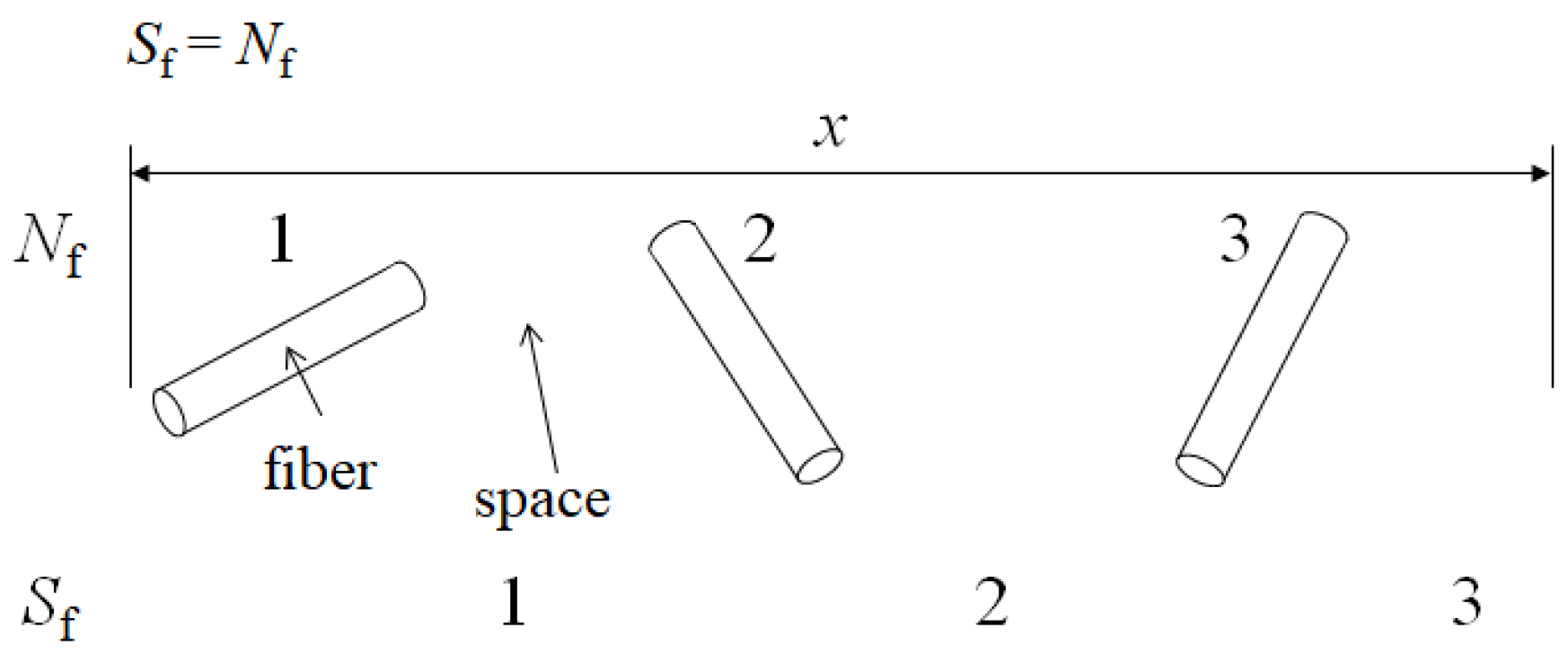

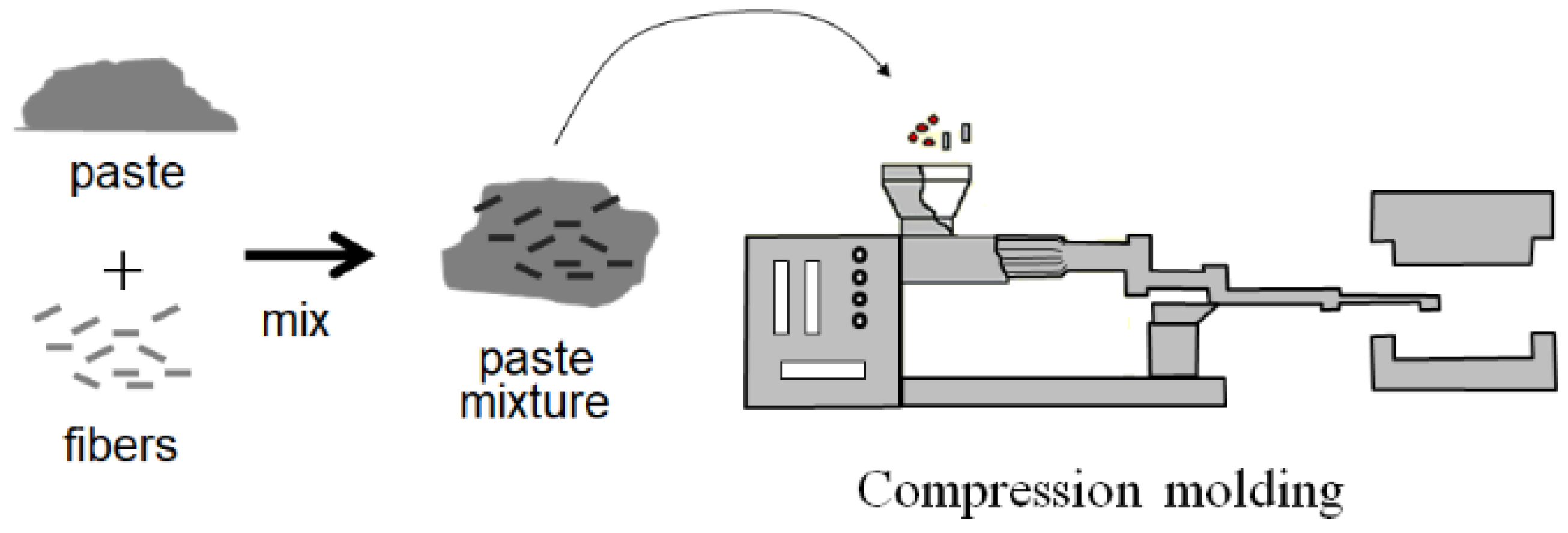
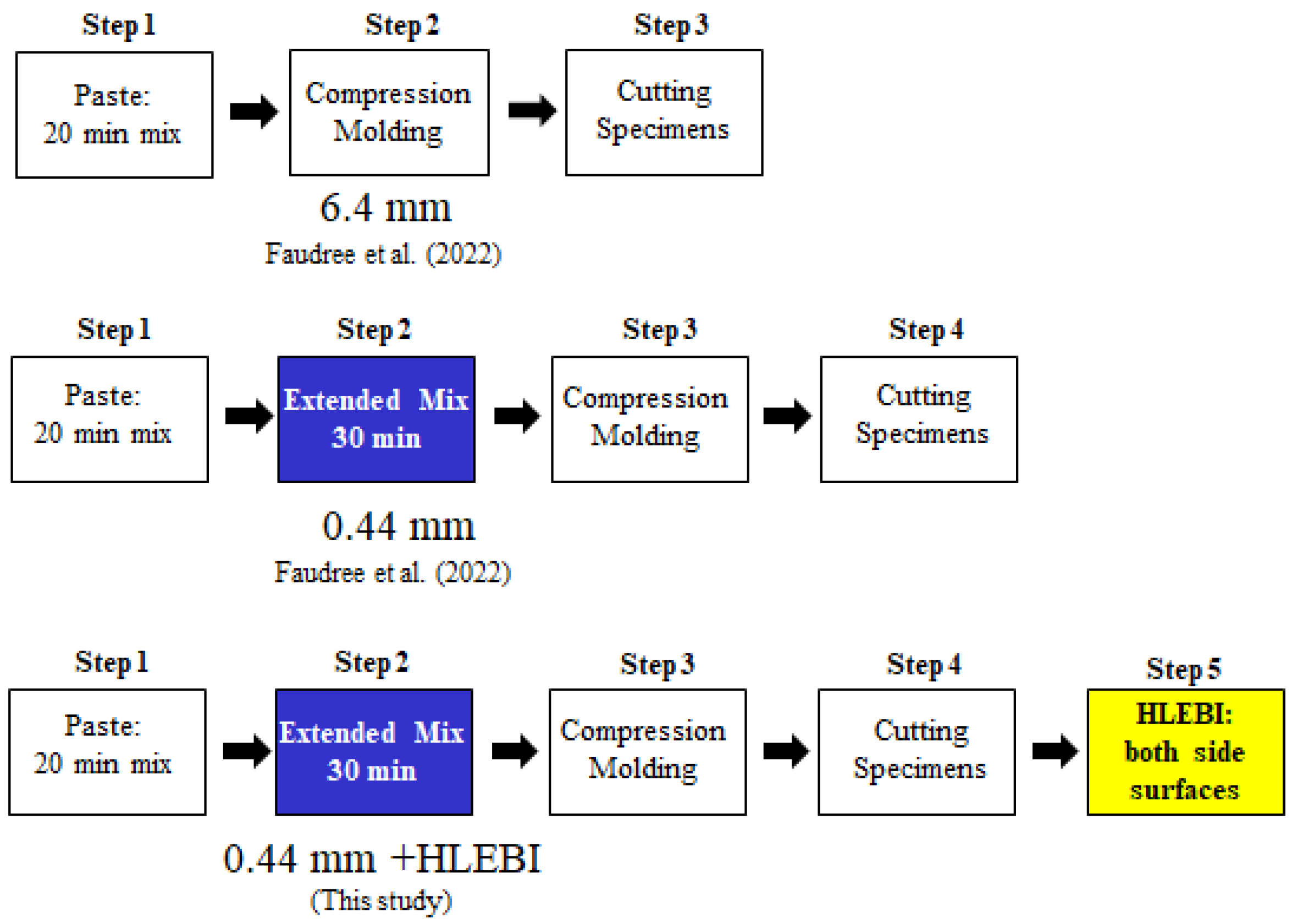

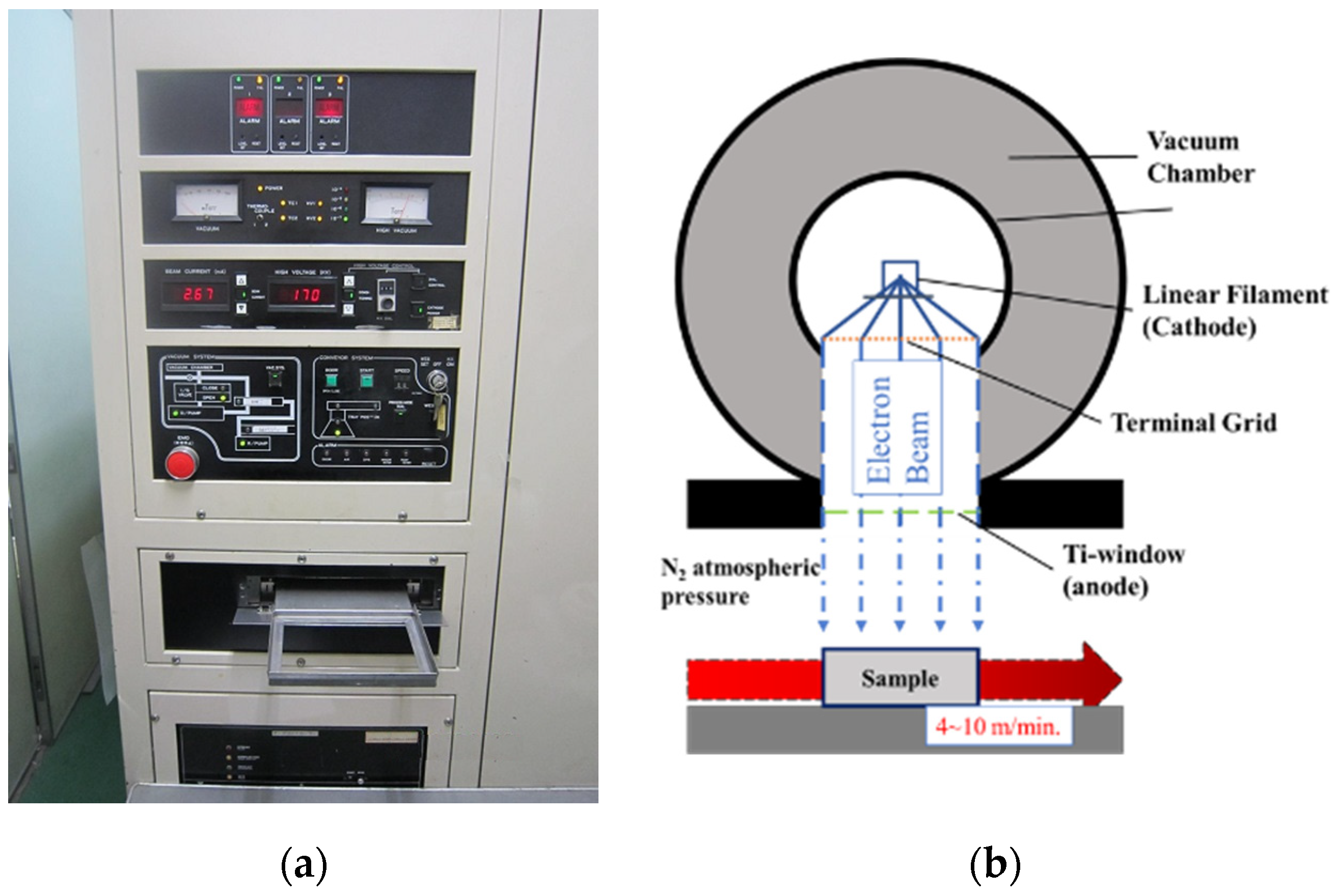
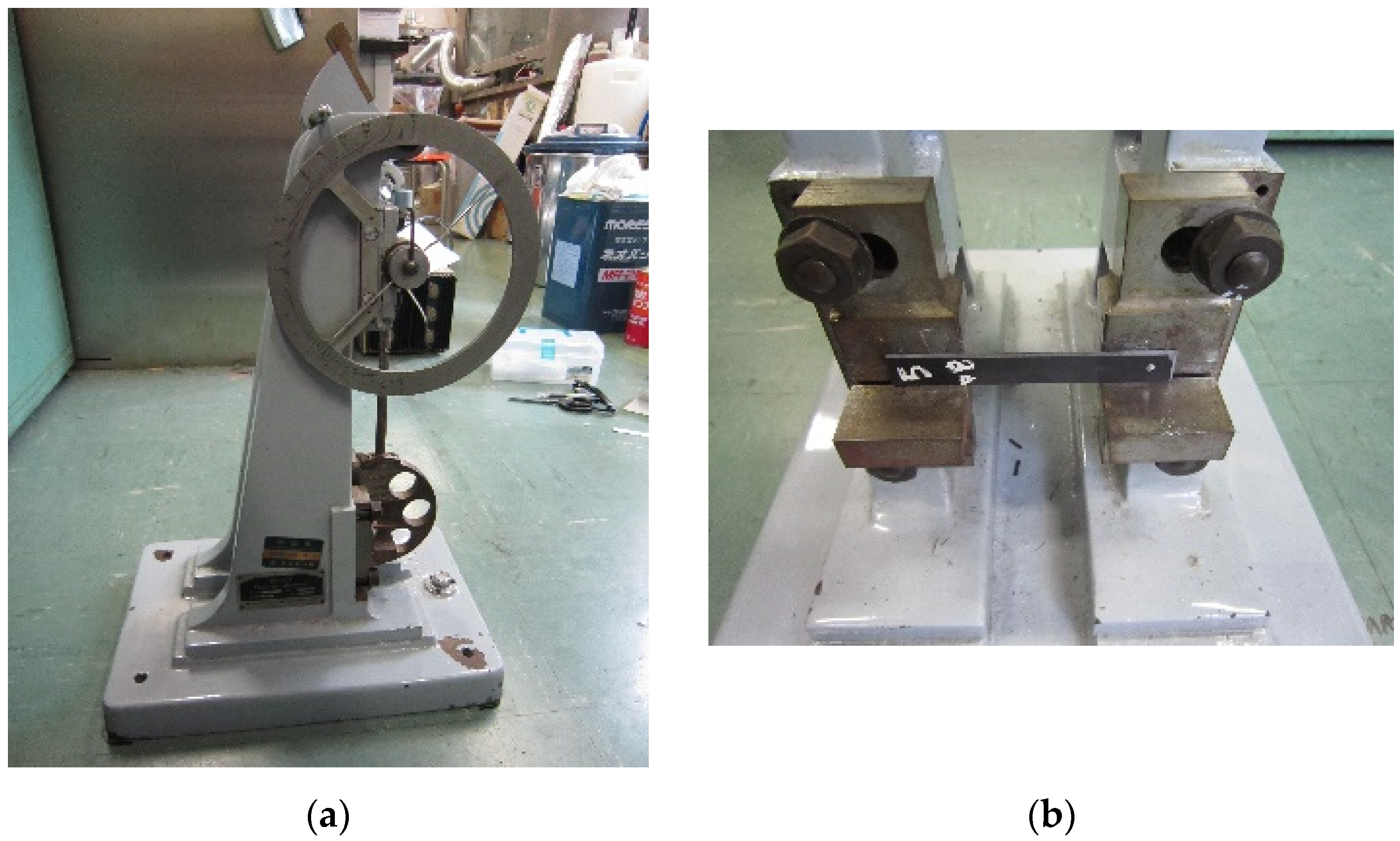

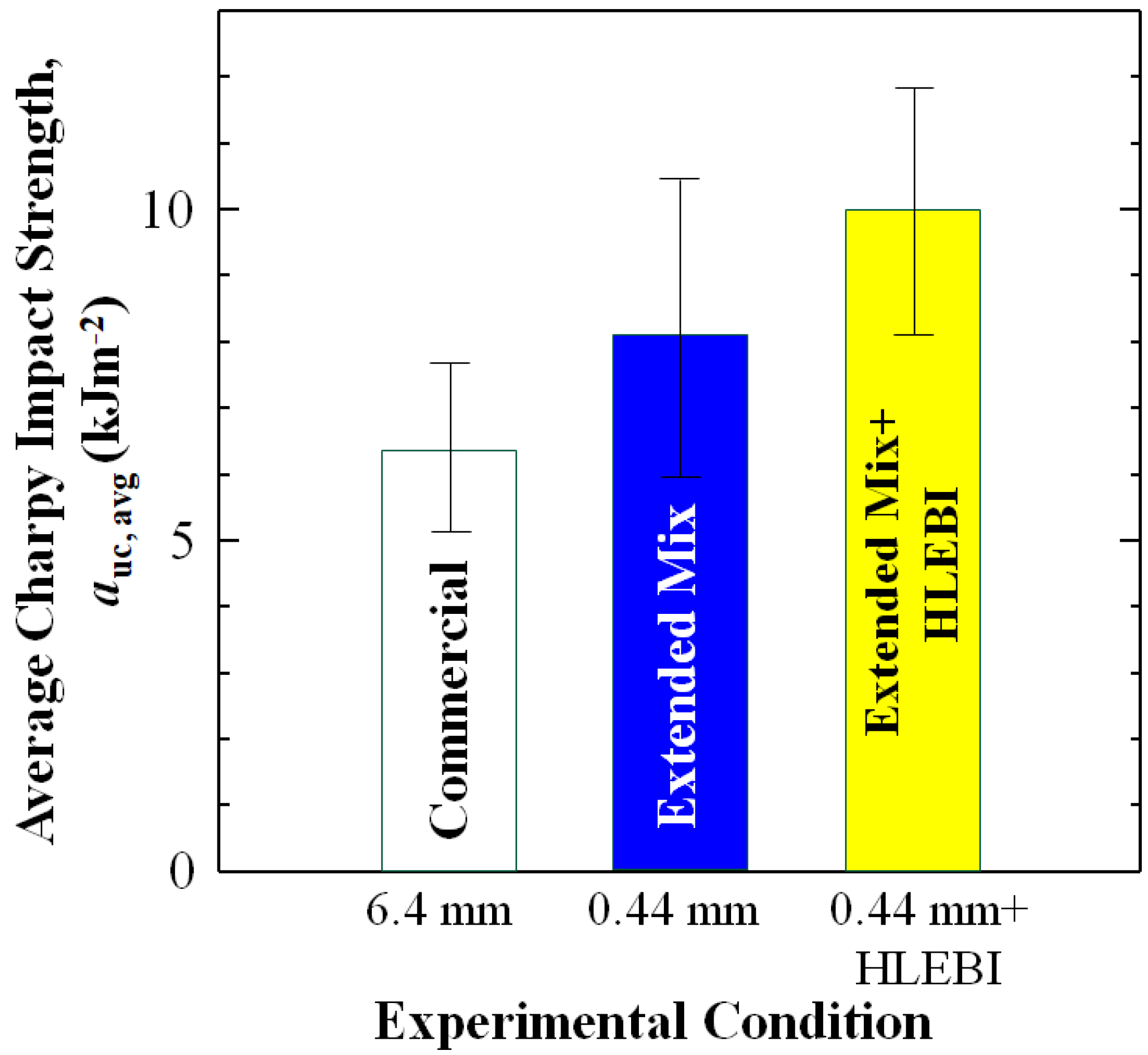

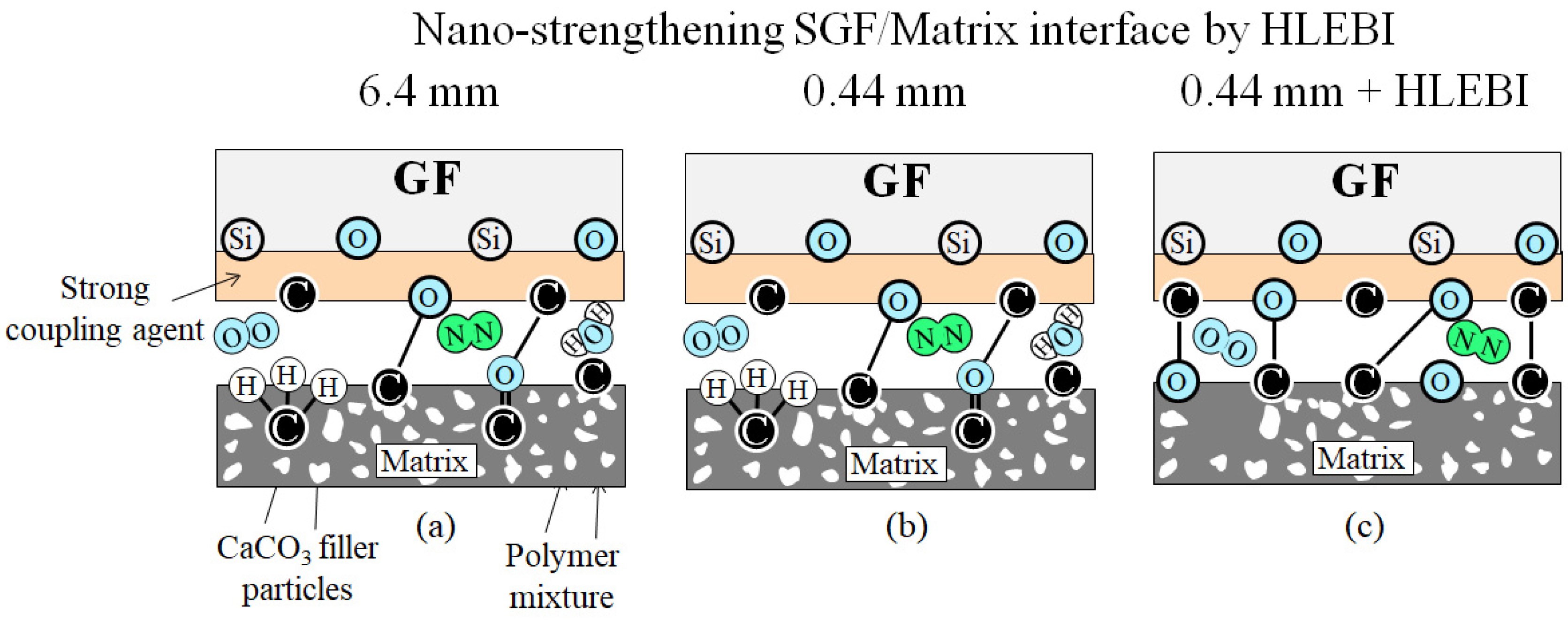
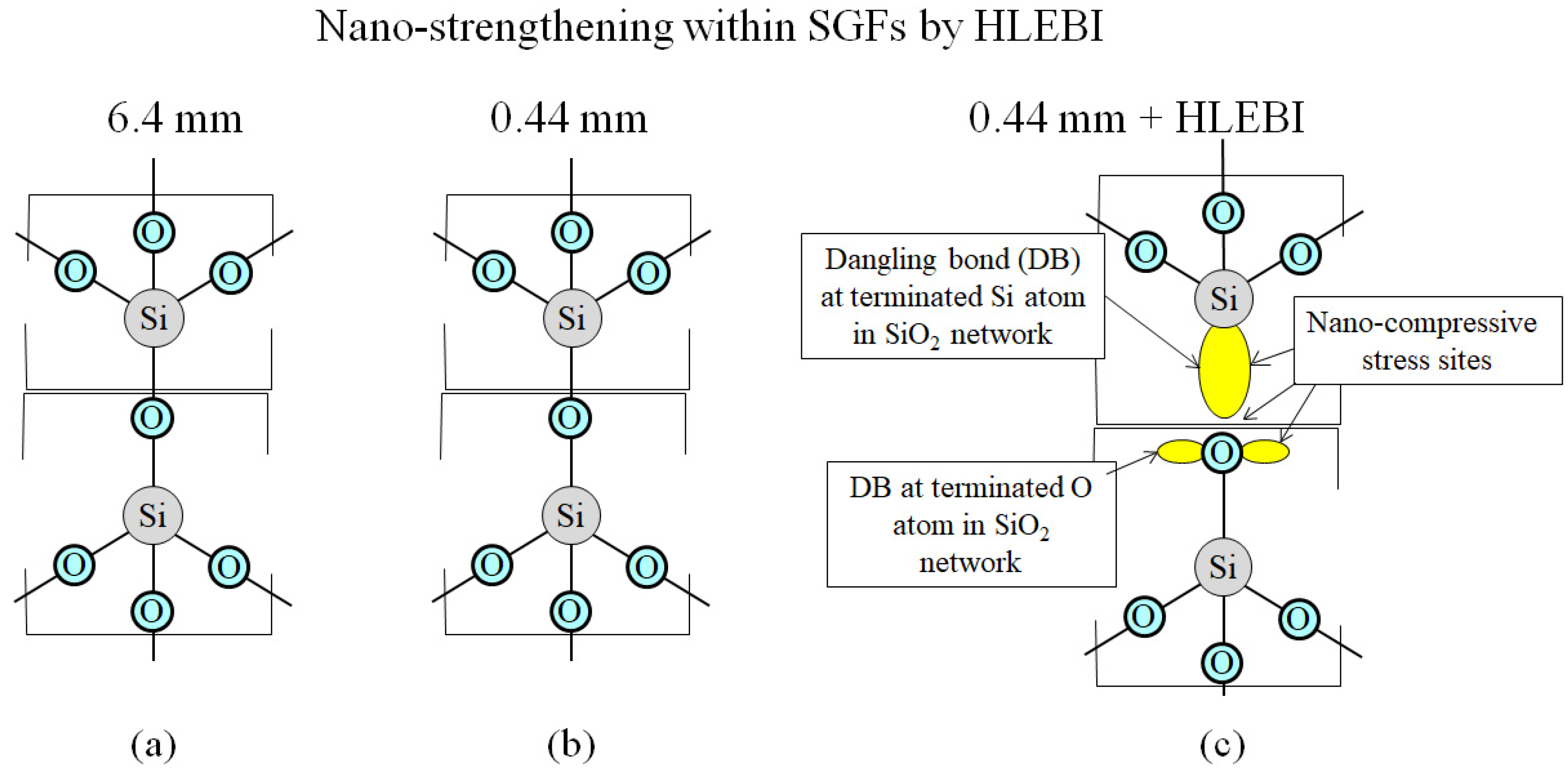
| COMPONENT | Wt.% |
|---|---|
| Propylene glycol maleate polyester | 13.75 |
| Styrene butadiene copolymer | 12.75 |
| Commercial E-glass fibers | 11 |
| CaCO3 filler | 55 |
| Aluminum silicate filler | 3 |
| Magnesium hydroxide | 0.5 |
| Proprietary initiators and inhibitors | 4 |
| PARAMETER | Condition |
|---|---|
| Mold pressure | 5.5 to 6.9 MPa (800 to 1000 psi) |
| Temperature | 422 K (149 °C) |
| Cure time | 2 min |
| Mold type | Matched metal die compression mold |
| Panel size | 304.8 × 304.8 mm (12 × 12 in) |
| Panel thickness | 2 mm |
| Vf (SGF) | 0.080 |
| Vf (CaCO3) | 0.377 |
| Vf (remaining polymer mixture) | 0.543 |
| Experimental Condition | 6.4 mm Untreated | 0.44 mm Untreated | 0.44 mm + HLEBI |
|---|---|---|---|
| Number of Specimens | 14 | 14 | 14 |
| Acceleration voltage | 170 kV |
| Irradiating current | 2.68 mA |
| Irradiation environment | N2 gas atmosphere |
| Residual O2 conc. | <300 ppm |
| Conveyor speed | 10 m min−1 |
| EB dose/sweep | 0.0432 MGy |
| Sweep time (one way) | 0.20 s |
| Gap interval bet. sweeps | 20 s |
| EB yield calc. | FWT Nylon dosimeter |
| Component | Density, ρ (g cm−3) | Dth (μm) |
|---|---|---|
| Polymer Mixture | 1.200 | 185 |
| Matrix Compos. | 1.847 | 120 |
| SGFRP-BMC | 1.917 | 116 |
| SGF | 2.620 | 84.5 |
| CaCO3 Filler | 2.800 | 79.1 |
| Pf | 6.4 mm Untreated | 0.44 mm Untreated | 0.44 mm+ HLEBI |
|---|---|---|---|
| 0.049 | 4.92 | 4.06 | 7.06 |
| 0.118 | 5.24 | 5.44 | 7.45 |
| 0.188 | 5.29 | 6.74 | 7.91 |
| 0.257 | 5.32 | 7.12 | 9.28 |
| 0.326 | 5.57 | 7.26 | 9.30 |
| 0.396 | 5.84 | 7.31 | 9.41 |
| 0.465 | 6.01 | 7.76 | 9.64 |
| 0.535 | 6.51 | 7.96 | 9.80 |
| 0.604 | 6.64 | 8.12 | 10.33 |
| 0.674 | 6.76 | 8.51 | 11.16 |
| 0.743 | 7.06 | 9.35 | 11.75 |
| 0.813 | 7.09 | 11.26 | 11.89 |
| 0.882 | 7.97 | 11.79 | 12.33 |
| 0.951 | 9.45 | 11.84 | 12.80 |
Disclaimer/Publisher’s Note: The statements, opinions and data contained in all publications are solely those of the individual author(s) and contributor(s) and not of MDPI and/or the editor(s). MDPI and/or the editor(s) disclaim responsibility for any injury to people or property resulting from any ideas, methods, instructions or products referred to in the content. |
© 2024 by the authors. Licensee MDPI, Basel, Switzerland. This article is an open access article distributed under the terms and conditions of the Creative Commons Attribution (CC BY) license (https://creativecommons.org/licenses/by/4.0/).
Share and Cite
Faudree, M.C.; Nishi, Y. A New Double-Step Process of Shortening Fibers without Change in Molding Equipment Followed by Electron Beam to Strengthen Short Glass Fiber Reinforced Polyester BMC. Materials 2024, 17, 2036. https://doi.org/10.3390/ma17092036
Faudree MC, Nishi Y. A New Double-Step Process of Shortening Fibers without Change in Molding Equipment Followed by Electron Beam to Strengthen Short Glass Fiber Reinforced Polyester BMC. Materials. 2024; 17(9):2036. https://doi.org/10.3390/ma17092036
Chicago/Turabian StyleFaudree, Michael C., and Yoshitake Nishi. 2024. "A New Double-Step Process of Shortening Fibers without Change in Molding Equipment Followed by Electron Beam to Strengthen Short Glass Fiber Reinforced Polyester BMC" Materials 17, no. 9: 2036. https://doi.org/10.3390/ma17092036
APA StyleFaudree, M. C., & Nishi, Y. (2024). A New Double-Step Process of Shortening Fibers without Change in Molding Equipment Followed by Electron Beam to Strengthen Short Glass Fiber Reinforced Polyester BMC. Materials, 17(9), 2036. https://doi.org/10.3390/ma17092036






